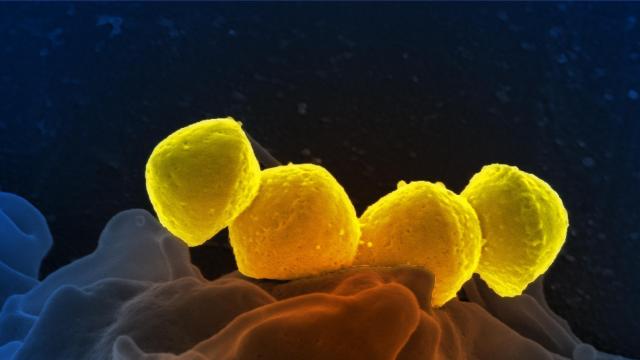There are actually several types of bacteria that can cause necrotising fasciitis, which is the more accurate name for this condition. “Necrotising” means that the cells in your body’s flesh are dying off; “fasciitis” means the result is inflammation of some connective tissues known as fascia.
Photo by the National Institute of Allergy and Infectious Diseases. The yellow things are Group A strep.
Group A Streptococcus is one of the more common culprits, but Klebsiella, Clostridium, E. coli and others can cause it too.
The bacteria don’t literally eat your flesh, but they do release toxins that dissolve it, so if you’re suffering from an infection you probably won’t appreciate the difference.
How likely am I to get this infection?
Thankfully, necrotising fasciitis is rare. The Centres for Disease Control and Prevention reports that about 1000 Americans get the form of it that’s caused by group A Streptococcus each year. Bad news: there are probably more cases than that. Good news: at least reports seem to be holding steady, so it’s probably not increasing.
How do people get necrotizing fasciitis?
The flesh-dissolving bacteria (that sounds worse, doesn’t it?) can live almost anywhere around us. But they can’t find an entry point until you have some kind of open wound, even a small one. That’s why it’s important to keep wounds clean and protected. If you’re wading around in filthy flood water, a band-aid isn’t going to cut it. Here’s the CDC’s advice:
- Keep draining or open wounds covered with clean, dry bandages until healed.
- Don’t delay first aid of even minor, non-infected wounds (like blisters, scrapes, or any break in the skin).
- Avoid spending time in whirlpools, hot tubs, swimming pools, and natural bodies of water (e.g., lakes, rivers, oceans) if you have an open wound or skin infection.
- Wash hands often with soap and water or use an alcohol-based hand rub if washing is not possible.
If you have a super strong immune system, you’re not likely to get necrotising fasciitis. But if you have diabetes, cancer, or anything that suppresses your immune system, you’re more at risk. (It’s still rare, though. Don’t panic, but do take care of your wounds.)
Often the earliest symptom is pain. It could feel like a pulled muscle or a bruise, and the wound may seem like it feels a lot worse than it looks. If the infection is near the skin, you might notice redness, heat, and swelling. Lots of infections can cause these signs of inflammation, so a hot red swollen wound isn’t necessarily flesh-eating bacteria.
But this collection of symptoms is a sign that you should seek medical help, especially if they come with fever, vomiting, or nausea.
Is it curable?
Sort of. Antibiotics can kill bacteria, so long as your infection isn’t the antibiotic-resistant kind. You may end up on massive doses of antibiotics for a while. But here’s the horrifying truth: it may not be possible to get antibiotics to all the areas of tissue that are already dead or dying, so the only way to remove the infection in some cases is literally to remove it — surgically cutting out chunks of muscle or whatever tissue has been destroyed. If the infection is bad enough, amputation might be necessary.
Necrotising fasciitis spreads fast, sometimes an inch per hour. so I’m going to say this again. If you have a painful wound with fever, chills, fatigue, or vomiting, get medical help right away.

Comments